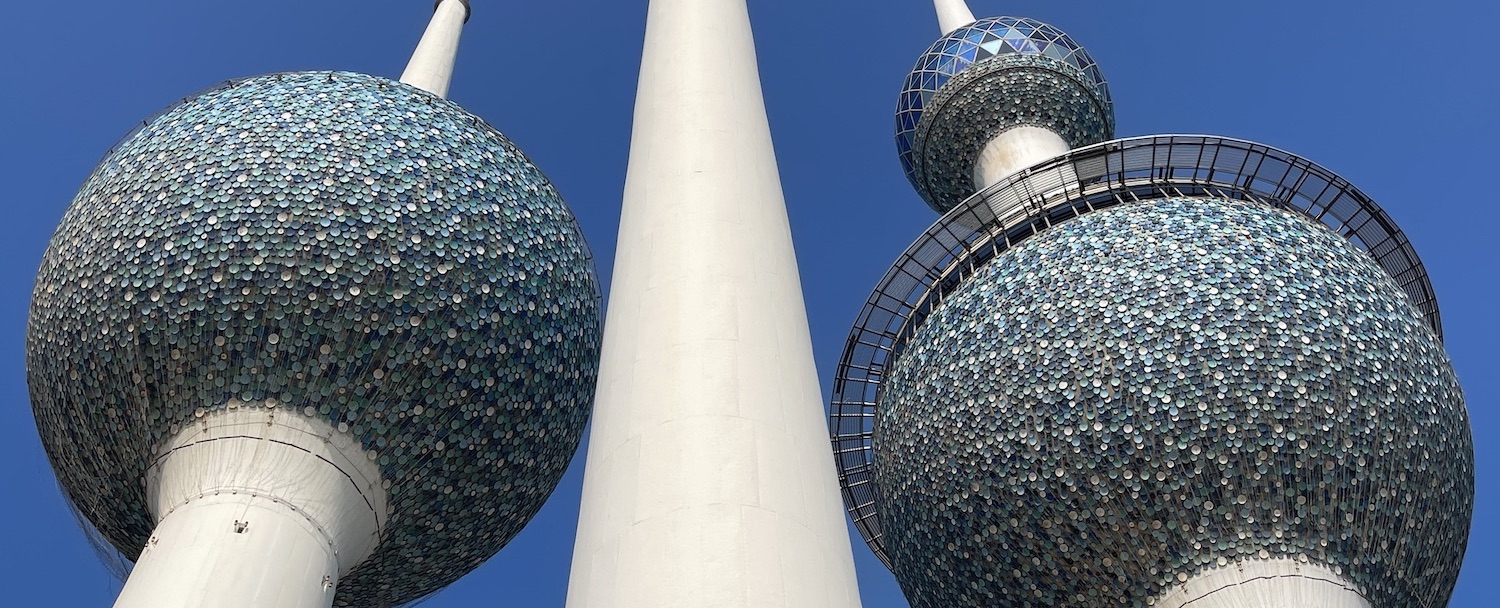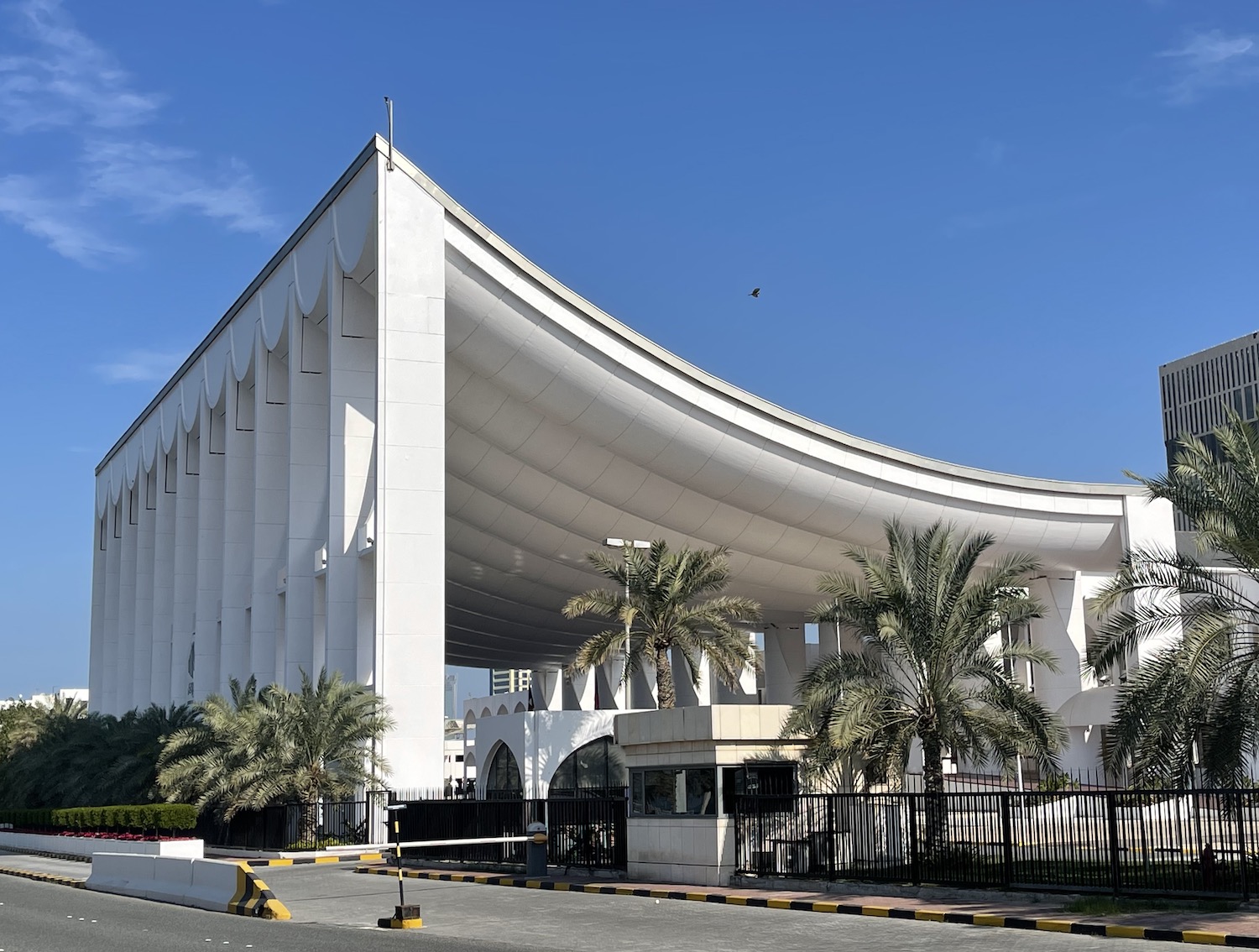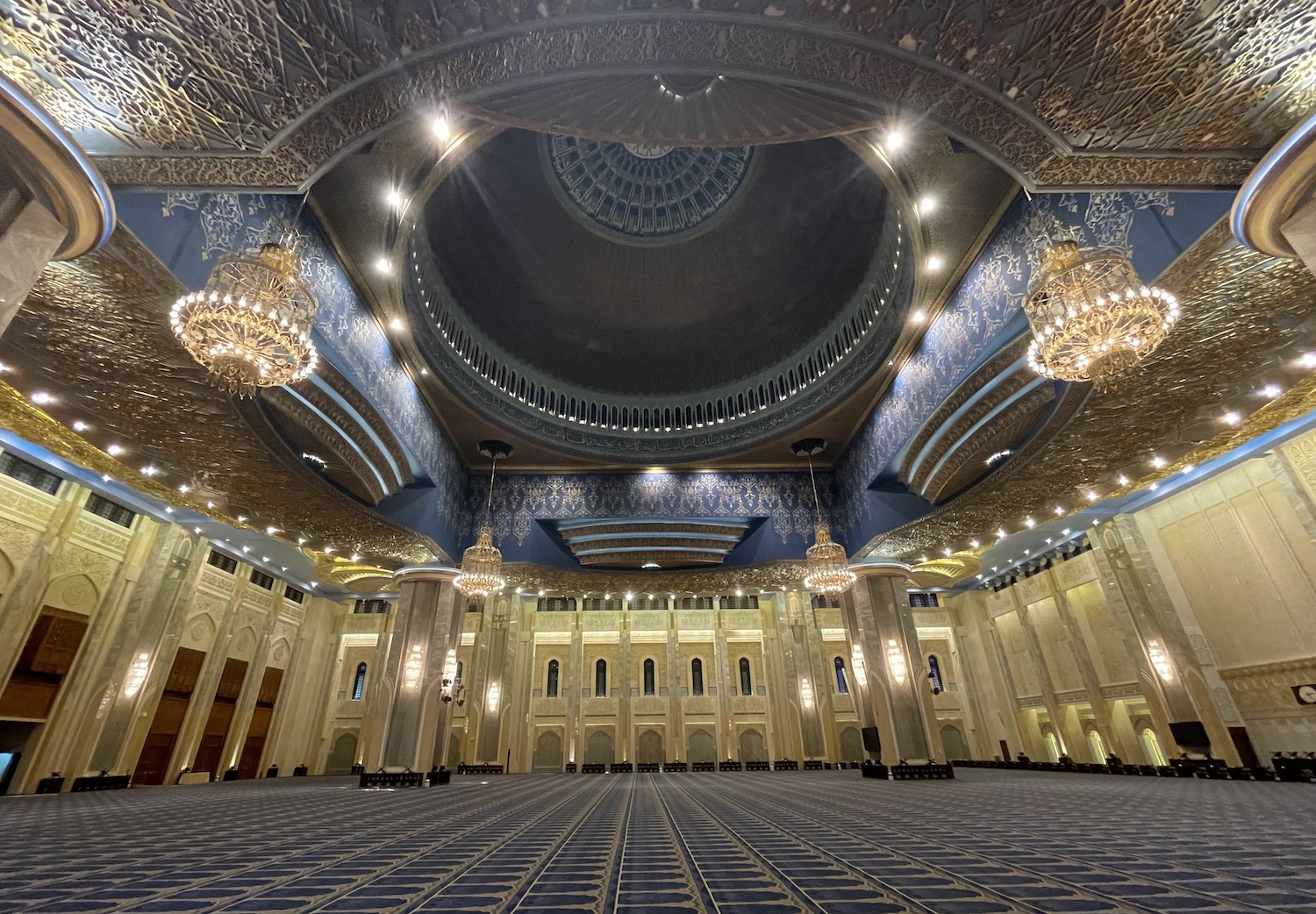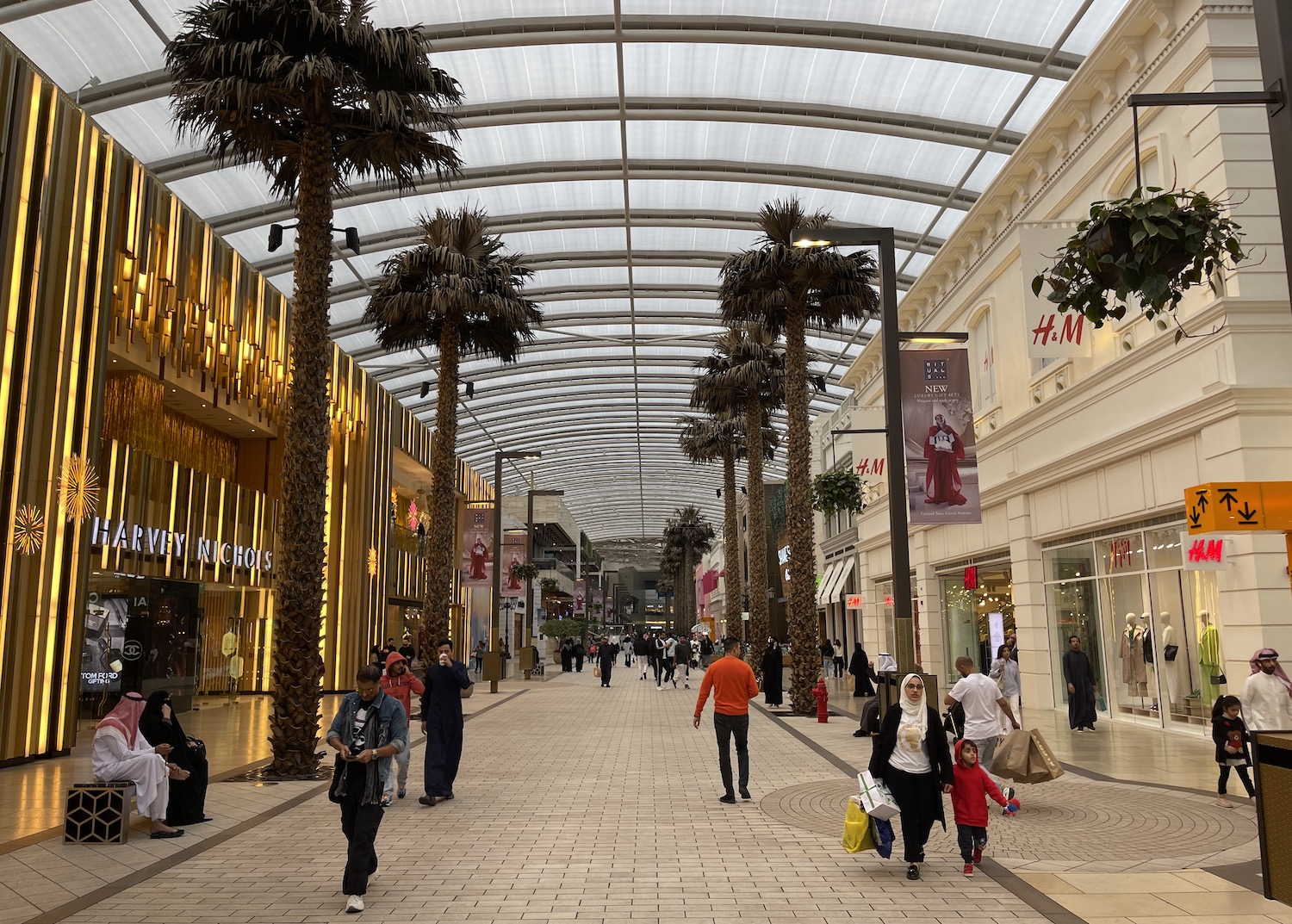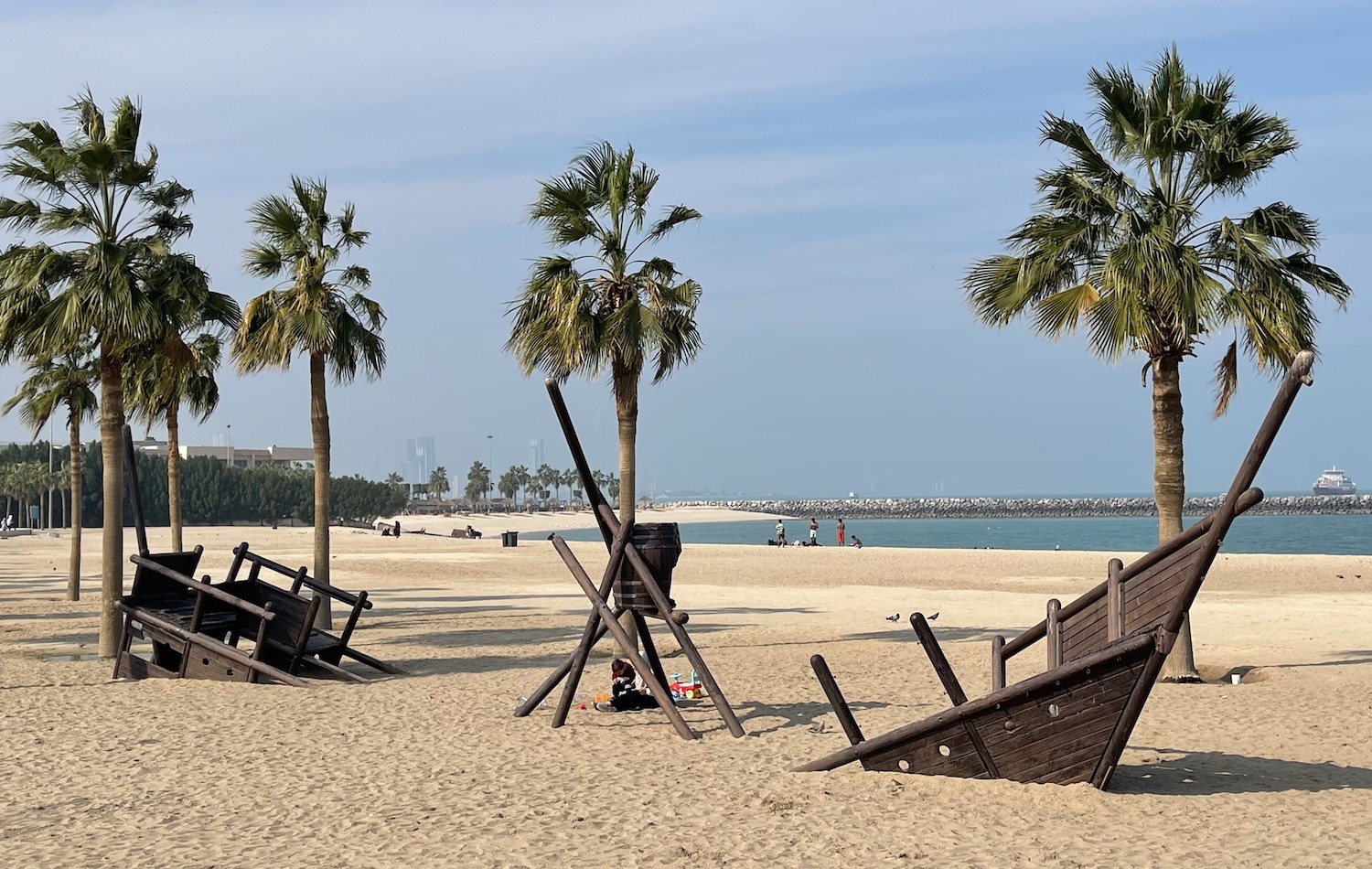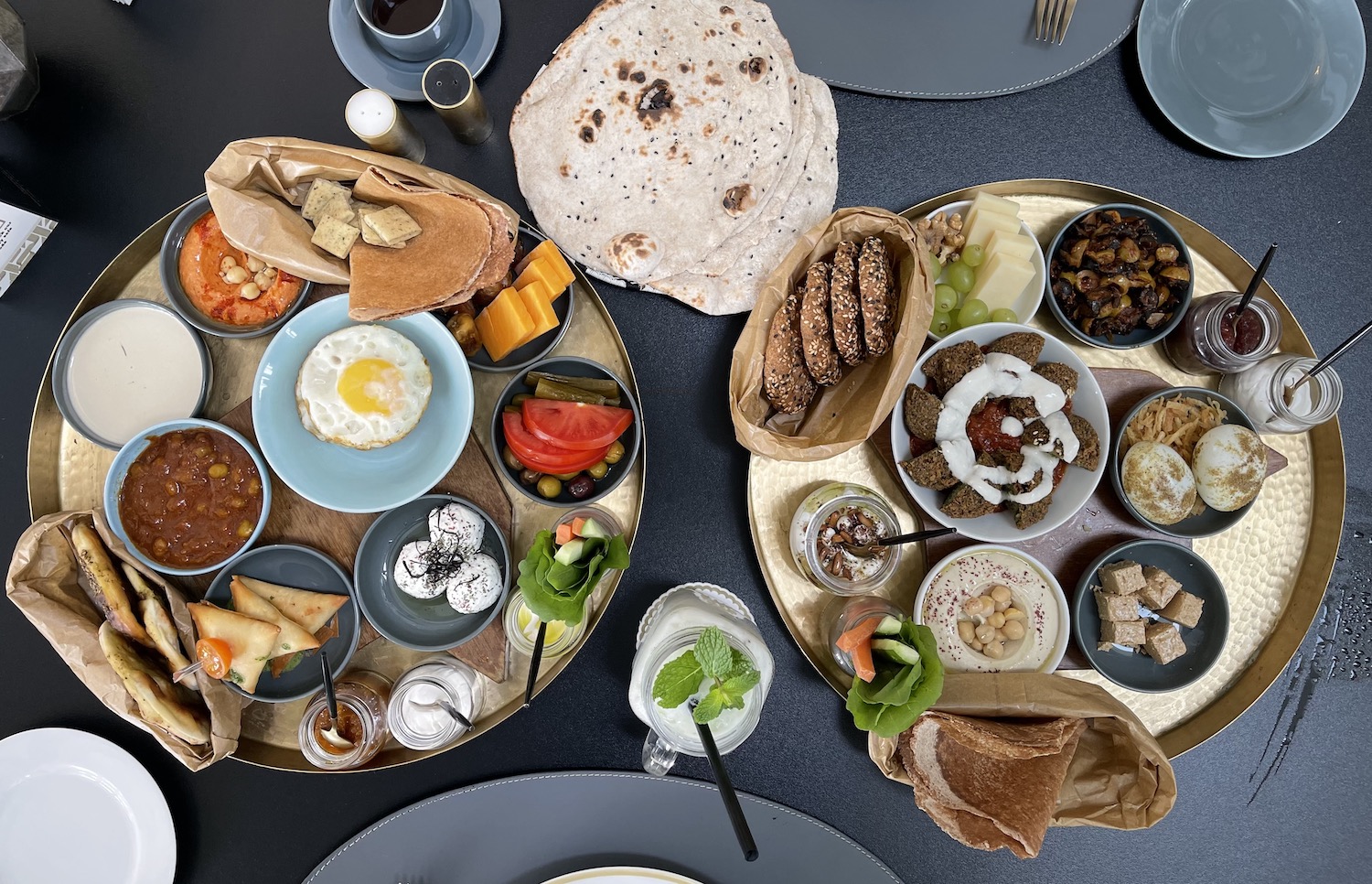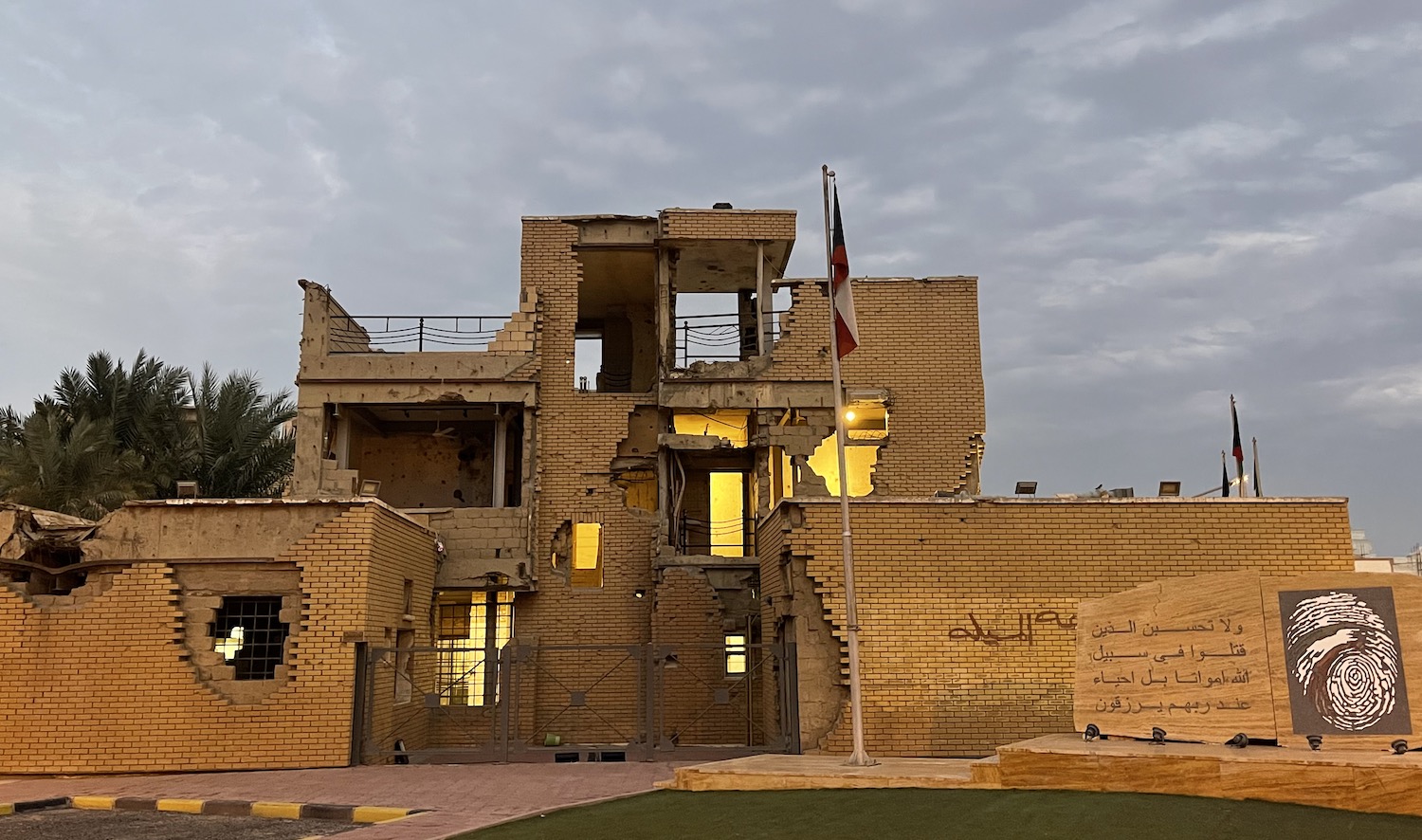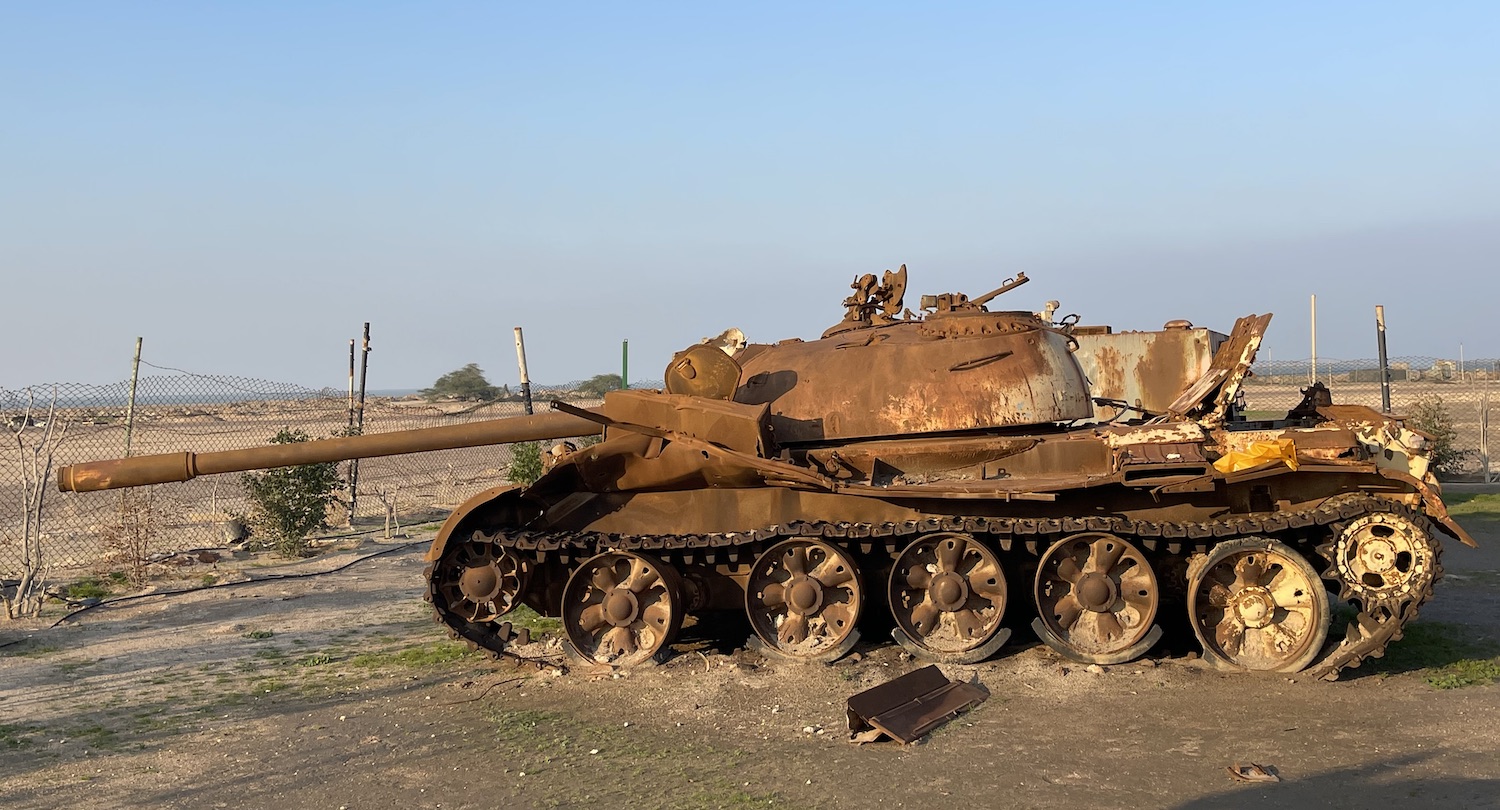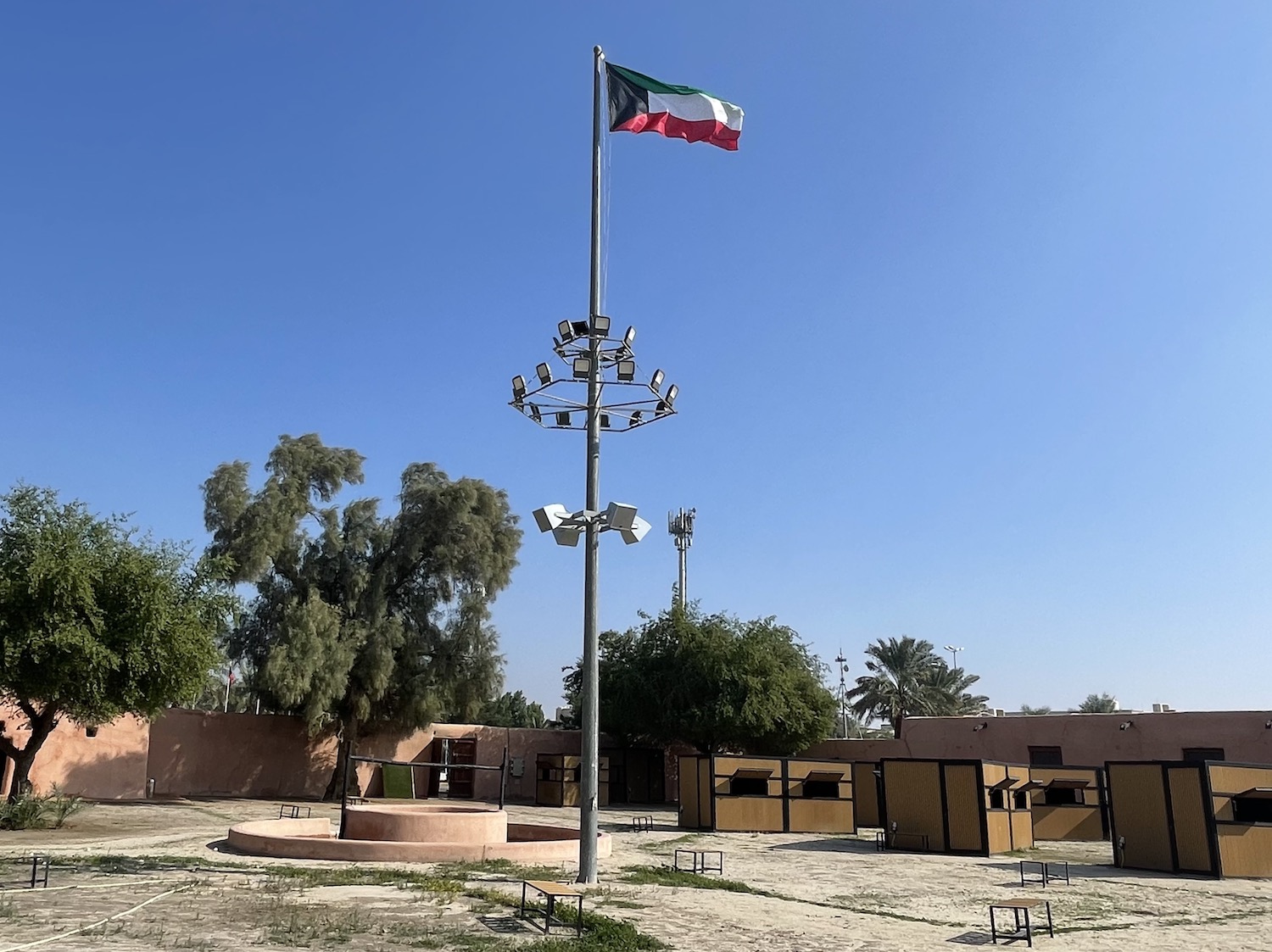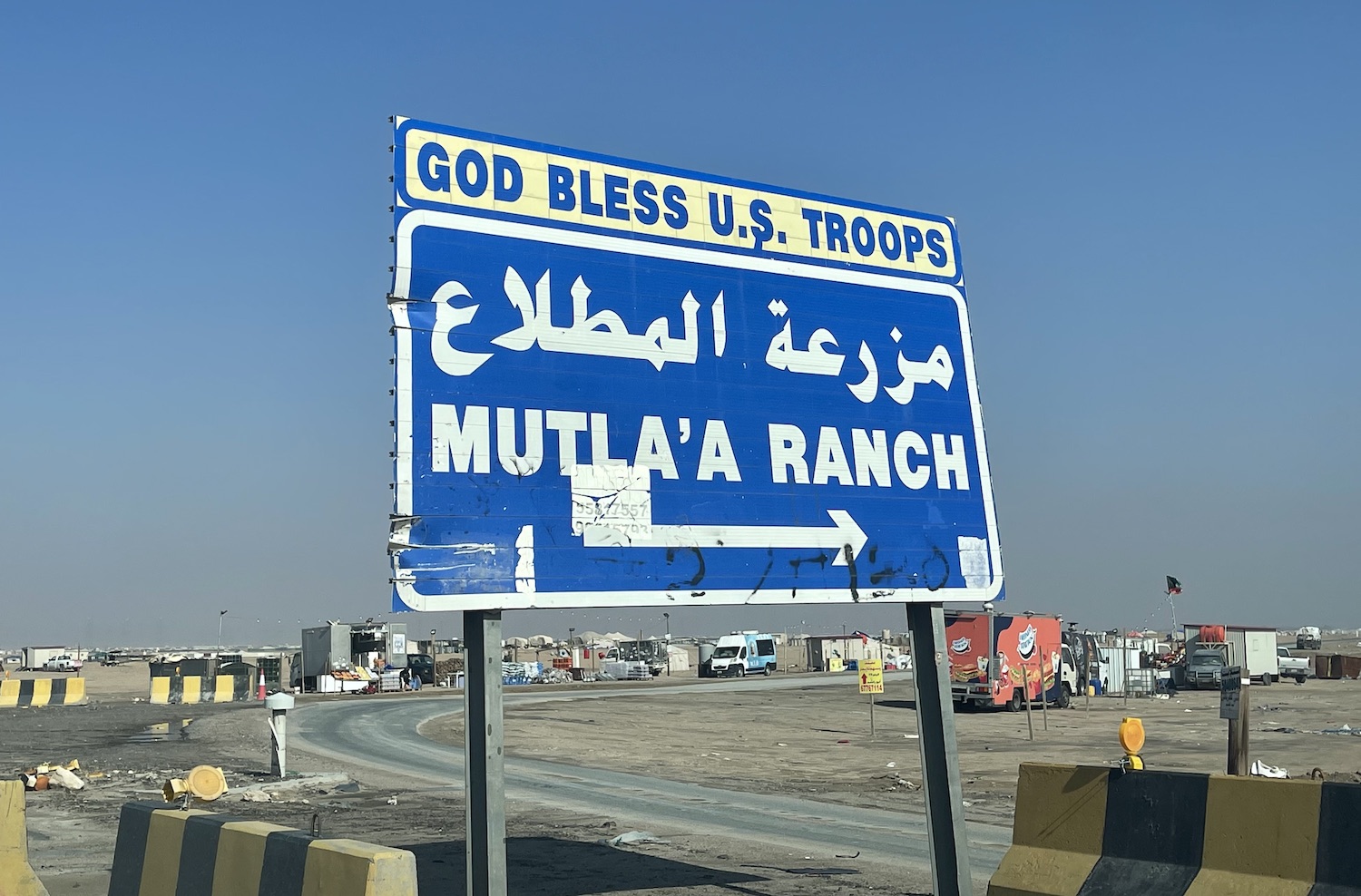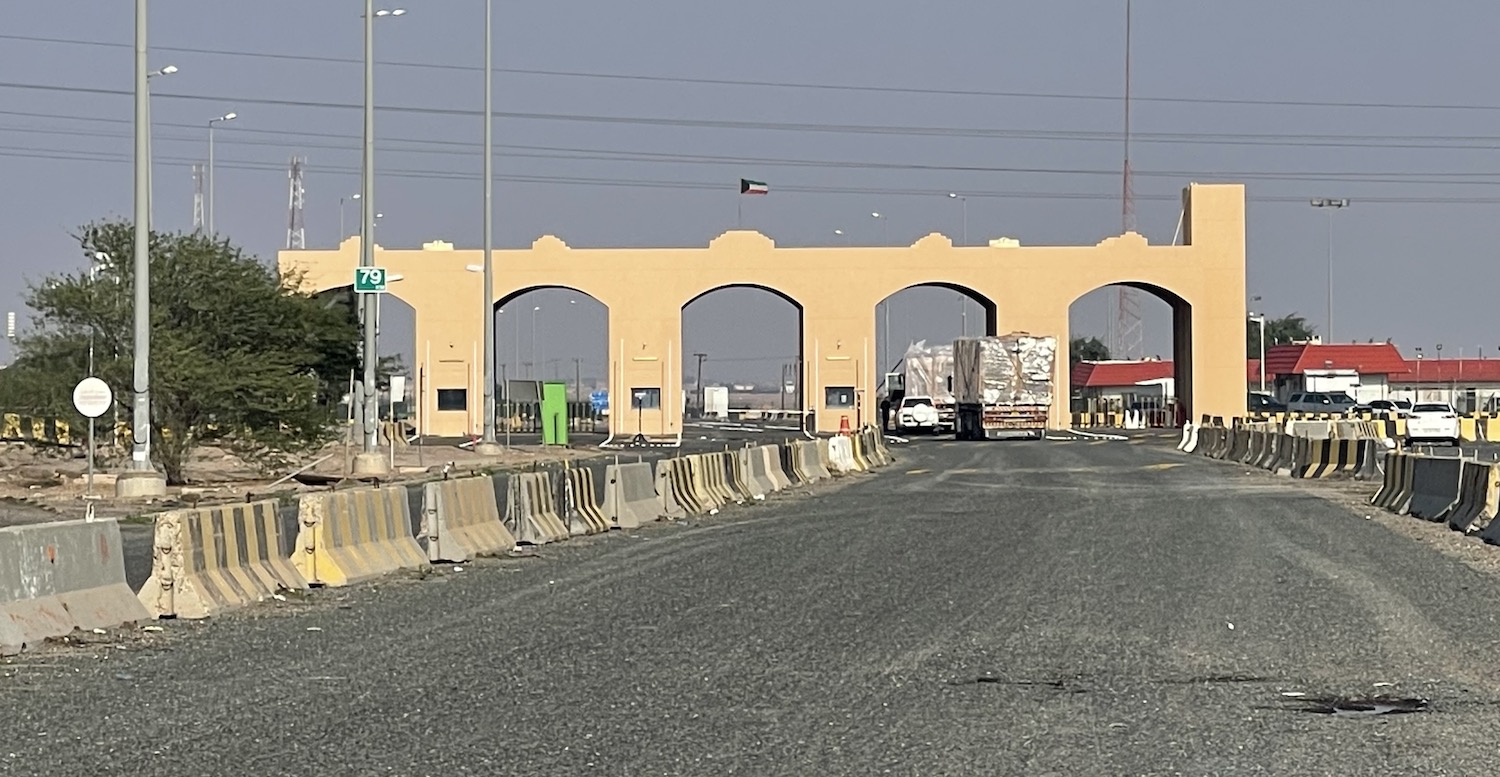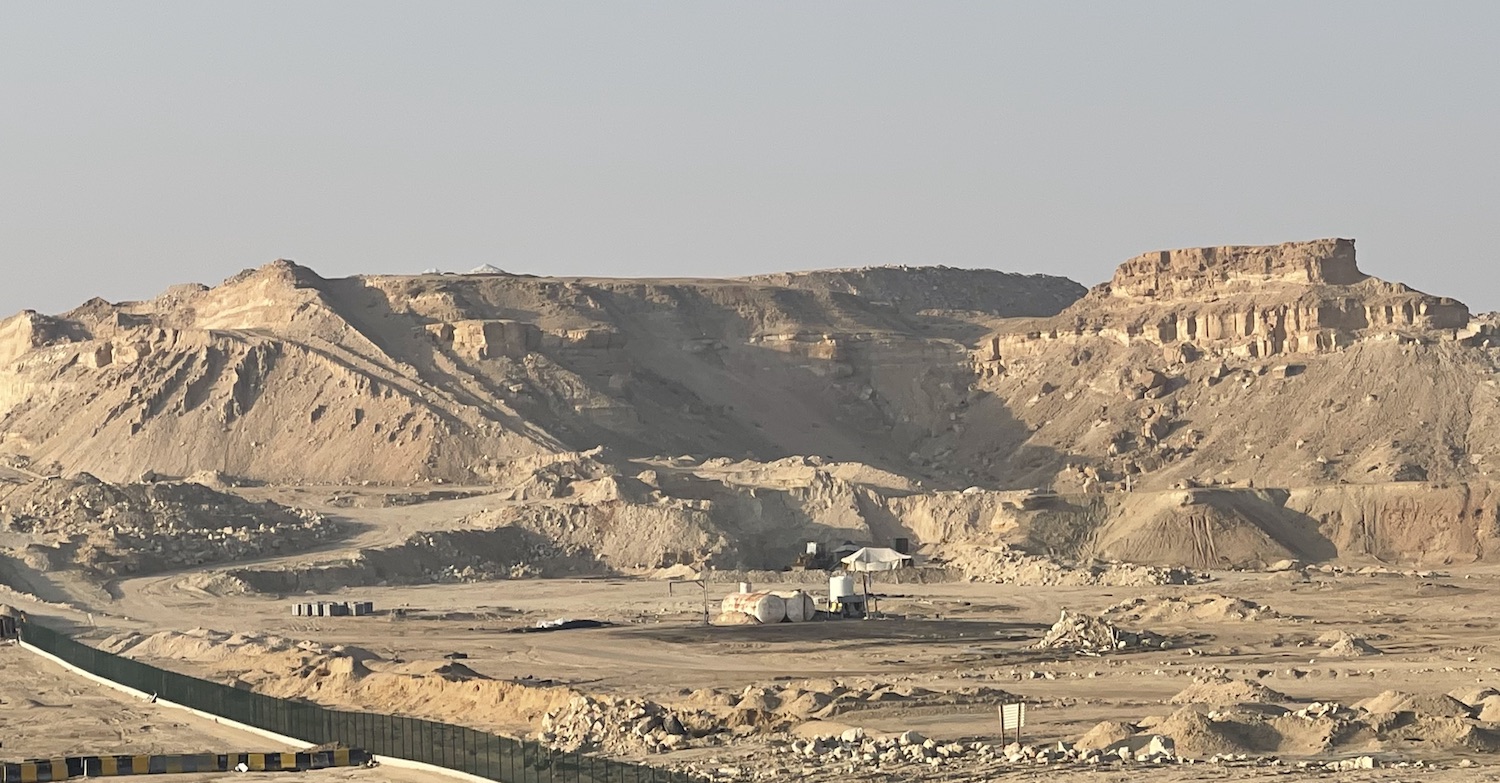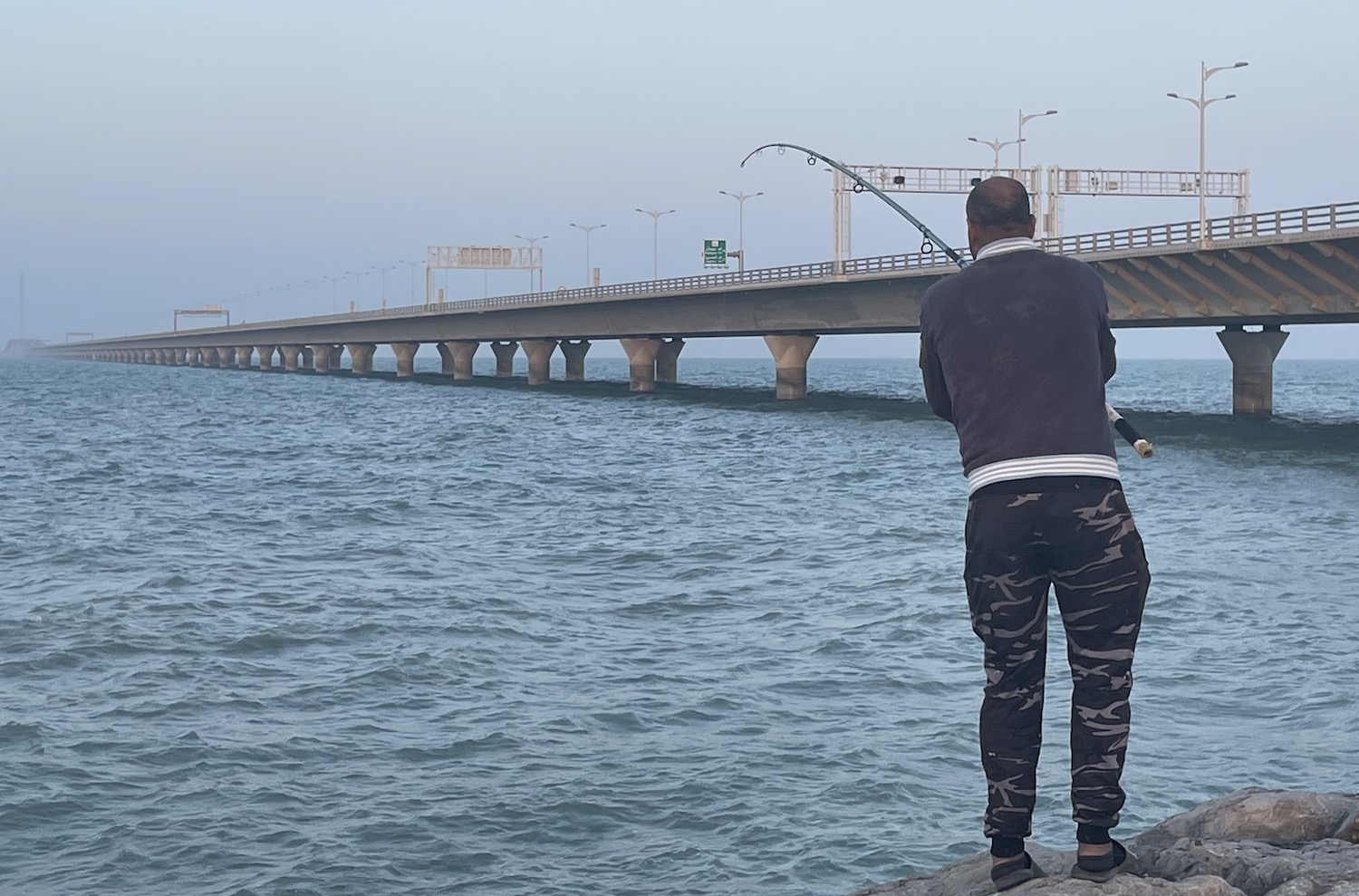Understandably, Kuwait is completely overshadowed in popular consciousness by the Gulf War that followed Saddam Hussein’s invasion in the early 1990s. It is way off the radar for even most intrepid travellers, who might think it a tiny splodge of desert with little to offer. And it is true that Kuwait has made next to no appeal to visitors, and in any case has developed zero infrastructure to cater for them. But, for me, that is part of the adventure in coming here.
It turns out, of course, that Kuwait City is a buzzy place with some terrific hotels and top notch restaurants, a substantial corniche and a handful of photogenic attractions, plus the region’s second best old souq (behind only Doha) and its very best modern mall (even above Dubai). On top of that there are some interesting ways of getting at the recent history and current culture of this pivotal land between the Arabian Peninsula and its troubled neighbours in Iraq and Iran. Out in the desert, highlights include the road from Iraq used by Saddam’s troops to invade and retreat, and a day at the camel races.
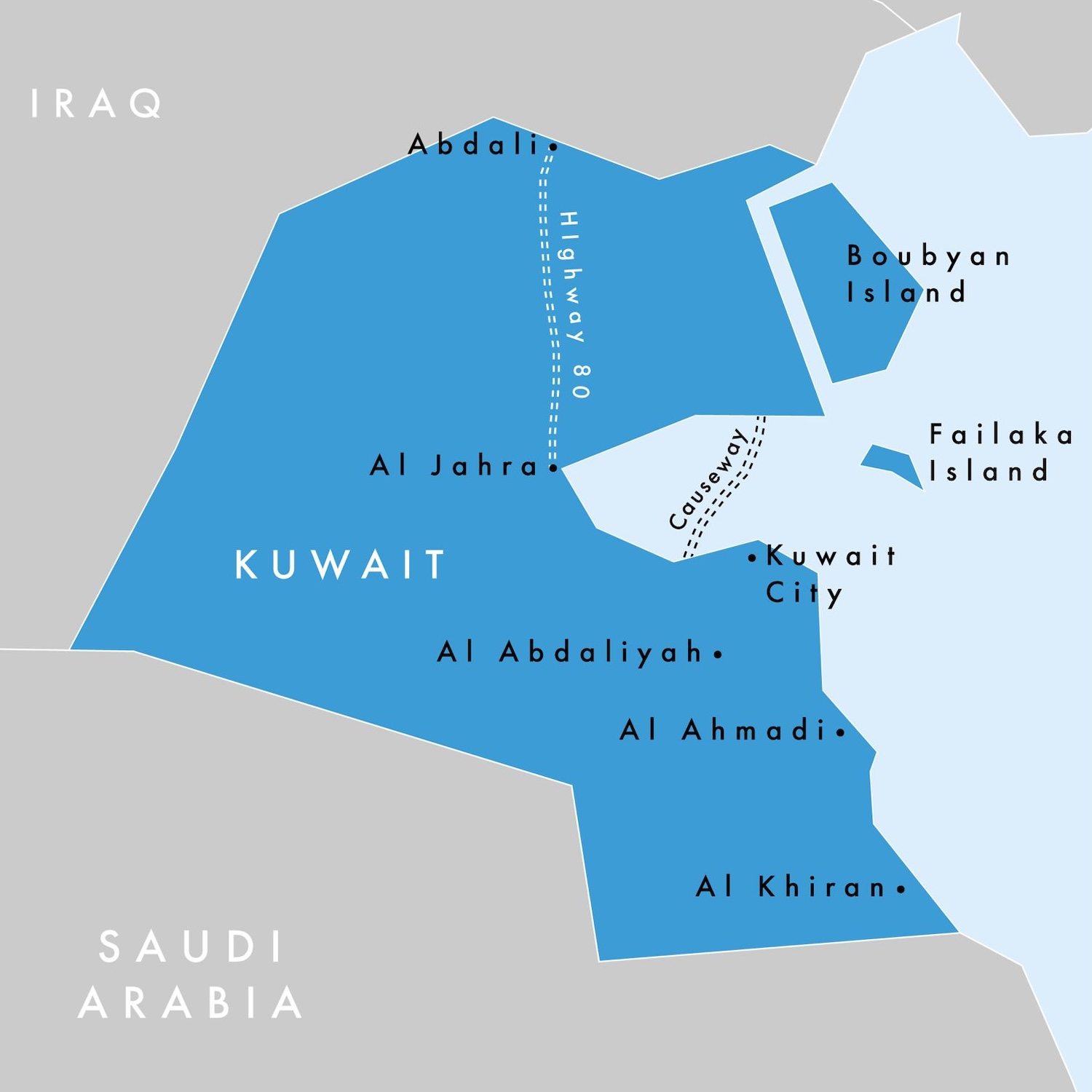
What is now the State of Kuwait was part of Mesopotamia until the Bani Utbah group of Arab tribes began migrating from central Saudi Arabia to the eastern peninsula. In 1756, they founded autonomous settlements here and appointed a sheikh from their Al Sabah clan as ruler.
At a strategic crossroads for trade routes between the Arabian Peninsula, Persia and India, the area inevitably attracted the claims of rival Great Powers. This started with the Portuguese in the sixteenth century, and included a squabble that was played out within the Al Sabah governing family at the end of the nineteenth century. After Emir Abd Allah II began to ally with the Ottomans, he was murdered and replaced by his brother Mubarak the Great, who granted control of foreign affairs to the British in 1899. Following the outbreak of World War I, Kuwait (meaning “fortress built near water”) was run as a British Protectorate until the Suez Crisis sparked the retreat of Empire and facilitated independence in 1961.
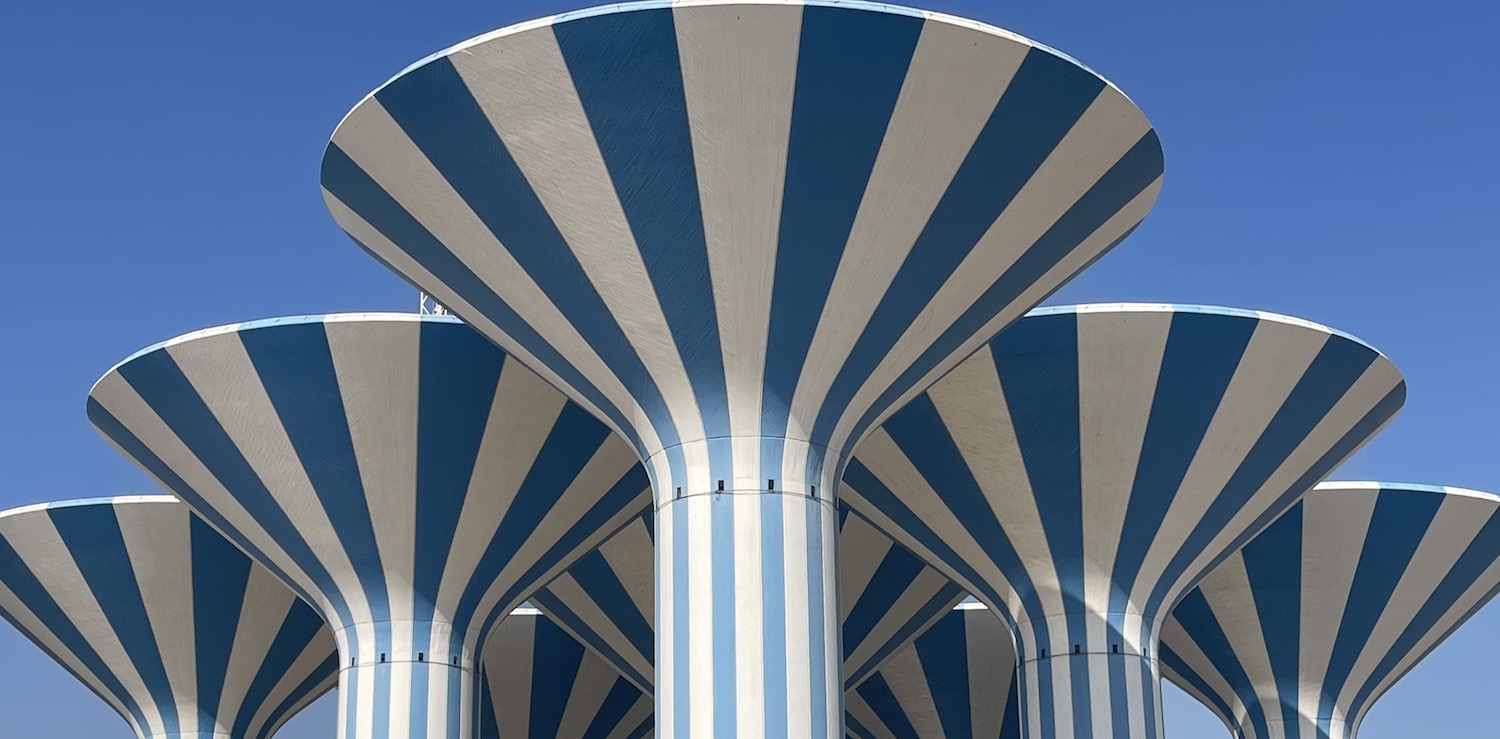
Oil had been struck in 1938 and crude exports begun in 1946, opening a Golden Era of economic success with investment in public works and state-building, using labour from Palestine, Egypt and India. However, this process of modernisation came to an abrupt end in August 1982 with the crash of Souk Al Manakh, the country’s unofficial stock market. This was housed in a multi-story car park in the ancient neighbourhood of Jibla, and took post-dated checks for highly speculative bets on unregulated foreign companies; at its peak, just before the bubble burst, Souk Al Manakh was the third largest stock market in the world by market capitalisation, behind only the US and Japan but ahead of the UK and France. (The stock market is the backdrop of the recent Netflix series The Exchange, a surprisingly feminist perspective on 80s Kuwait.) All financial institutions except the National Bank of Kuwait suddenly found themselves insolvent, forcing the government to set up the marvellously-named Difficult Credit Facilities Resettlement Programme. Yet this in turn came to another sudden stop on 2 August 1990 with the invasion of Iraq.
Why did Iraq invade Kuwait? The underlying reasons were to gain control of Kuwait’s oil wealth and strategic frontage on the Persian Gulf, as well as to promote Pan-Arabism under Iraqi leadership. The proximate causes were the desire to generate domestic popularity after the failure of the Iran-Iraq War, and the refusal to pay a debt of more than US$65bn to Kuwait that covered some of its costs for that conflict.
Kuwait’s military totalled 16,000 personnel, organised into just three brigades, while Iraq had more than 1.5 million soldiers, the fourth largest army in the world. Unsurprisingly, Saddam’s forces occupied all 17,820km2 of this tiny country within two days. It was initially run by a puppet regime called the Republic of Kuwait before being completed annexed as the Nineteenth Governorate of Iraq.
United Nations Security Council Resolution 678 legitimised the biggest military alliance since World War II, a coalition of thirty-five countries led by the United States, which responded by launching Operation Desert Storm. Colossal aerial and naval bombardments began on 17 January 1991, and a massive ground assault followed on 24 February, ending with the liberation of Kuwait on 26 February. More than half of the US$60 billion costs to mobilise the coalition were paid by the Kuwait government-in-exile and Saudi Arabia.
Inevitably, the Gulf War affected every aspect of Kuwaiti life and scars the country still, forming the backdrop for every visit right up to today. More than half the population fled, and although most returned within a year, many non-nationals, notably the Palestinians, were forbidden from doing so. Divisions emerged between those who had left, including the ruling Al Sabahs, also accused of corruption, and those who had stayed to fight in the resistance, triggering demands for political reform, not least of the rubber-stamp National Assembly. Political dissent, fomented by stateless Bedoon tribal people who had been suffering ethnic cleansing, erupted among the wider public during the 2011-12 Arab Spring, which swept away Prime Minister Nasser Al Sabah and his entire Cabinet until stability was imposed.
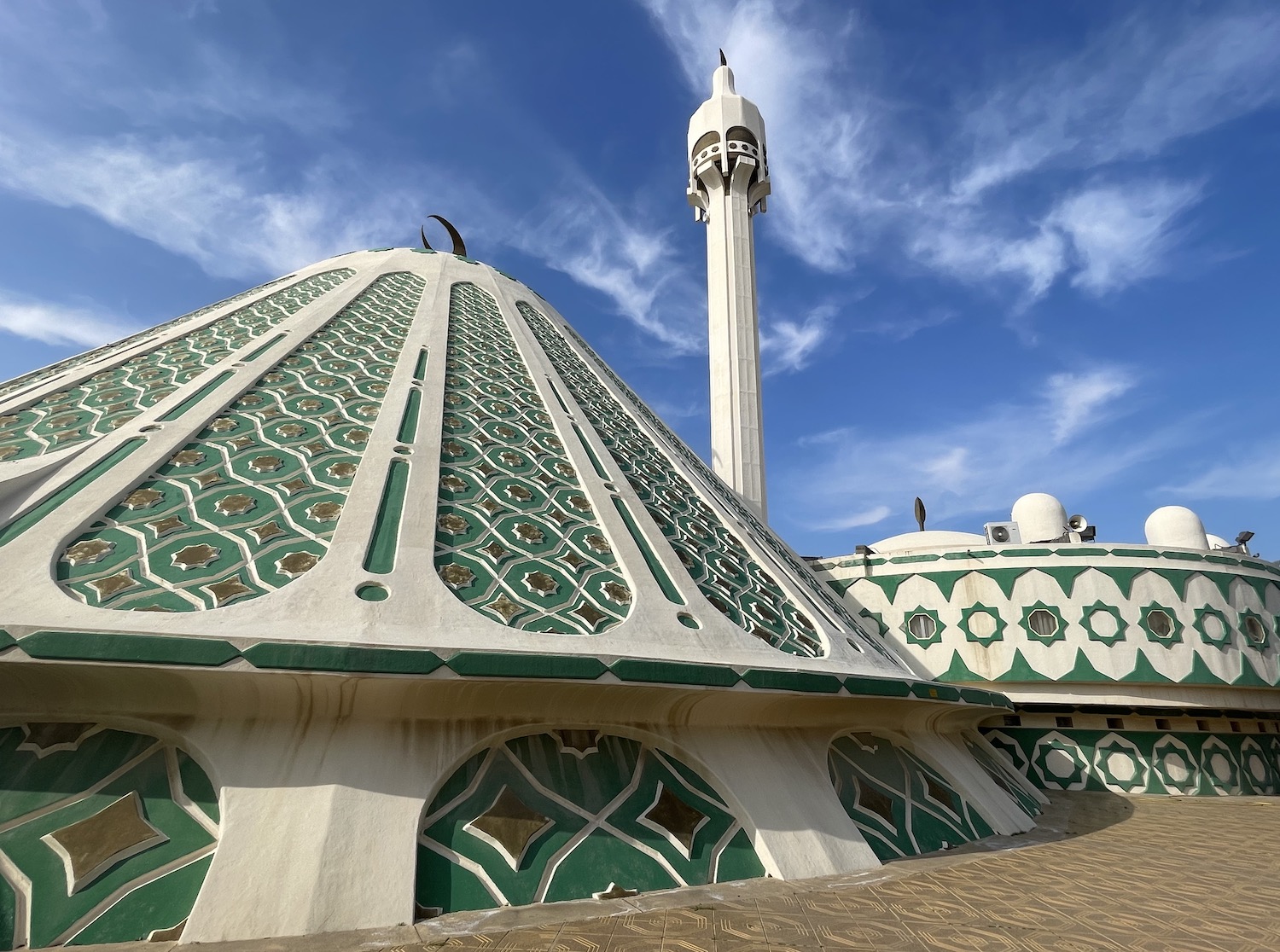
Land borders with Iraq to the north and Saudi Arabia to the south, as well as a maritime border with Iran to the east, continue to leave the country feeling vulnerable. Fear of further invasion has led Kuwait to host what is currently the largest US military presence in the Middle East, and inhibited investment in modernisation, causing it to fall behind its GCC allies in the past few years as they began to put up skyscrapers and diversify their economies.
After decades of neglect, the government is now beginning to follow some of the blueprint for change drafted by Saudi Arabia. They have their own “Vision 2035”, a national development plan for what they call the New Kuwait, which aims to increase foreign direct investment by 300%, broaden the economy from reliance on petrochemicals, and boost tourism. To have any chance of bringing this about, Kuwait is dependant on a high proportion of foreign workers. Of the current population of 4.5m, only one-third are Kuwaiti citizens; the rest are almost all manual labourers from South Asia and housemaids from the Philippines, though outside the oil industry there are virtually no Westerners at all.
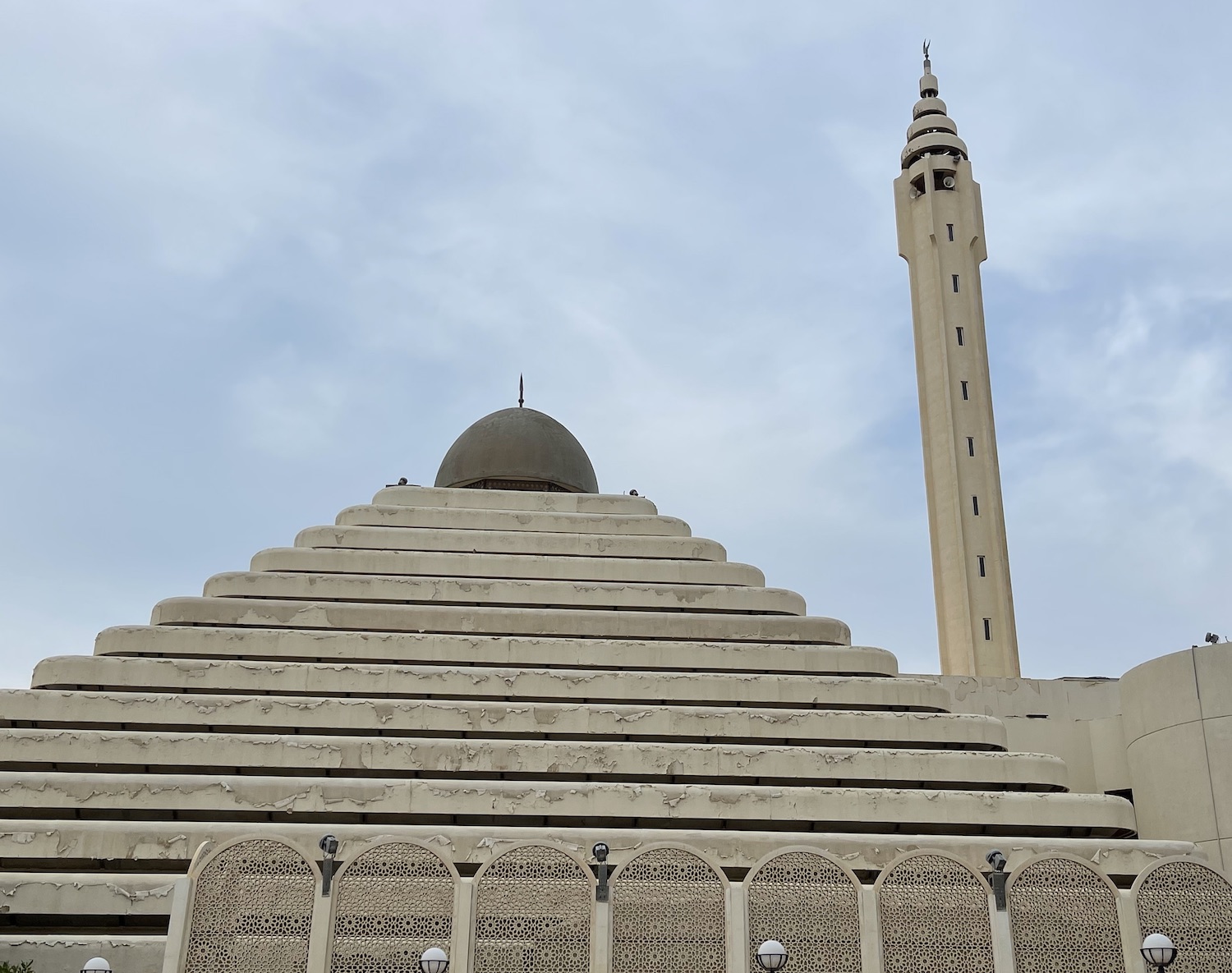
Tourism to Q8, as it is sometimes styled here, is certainly in its infancy right now, which is of course precisely why it is the most exciting time to come. There are a few visitors from across the GCC countries but almost none from further abroad; we saw not one other white face in our ten days here over New Year, when I assume expats head home for the holiday season. The large hotels might be used to catering for business people flying in and out, but they are nonplussed if you ask them what there is to see for fun.
Summers are boiling, once reaching 54°C, the highest ever recorded in Asia. Winters are surprisingly cold, frequently falling below 10°C, when rain and even sleet can fall in the desert. So the best time to come is spring and autumn. And most things you want to visit are closed between 12.30 and 4.30 every afternoon and all day Fridays.
Kuwait City
Founded as a little fishing village by the Portuguese in 1613, today Kuwait City sprawls all along the coast south of Kuwait Bay and houses two-thirds of everyone who lives in the country. Despite formal adherence to Islam, where alcohol is banned and the dress code is modest, this feels like a relaxed place at ease with itself. Unlike in some other Gulf countries, local men and women mix freely in public, and there is a blend of American influence in everything from retail outlets to modern coffee shop culture. Although you are likely to be more or less the only foreign pleasure-seeker here, there is certainly enough to do to have a lovely long weekend, zooming around in Careem cabs.
The airport is just beyond the southern suburbs and fifteen minutes into town are a pair of hotels that make a good base to access everywhere you will want to go: the Grand Hyatt at the 360 Mall and the Crowne Plaza in Al Thuraya.
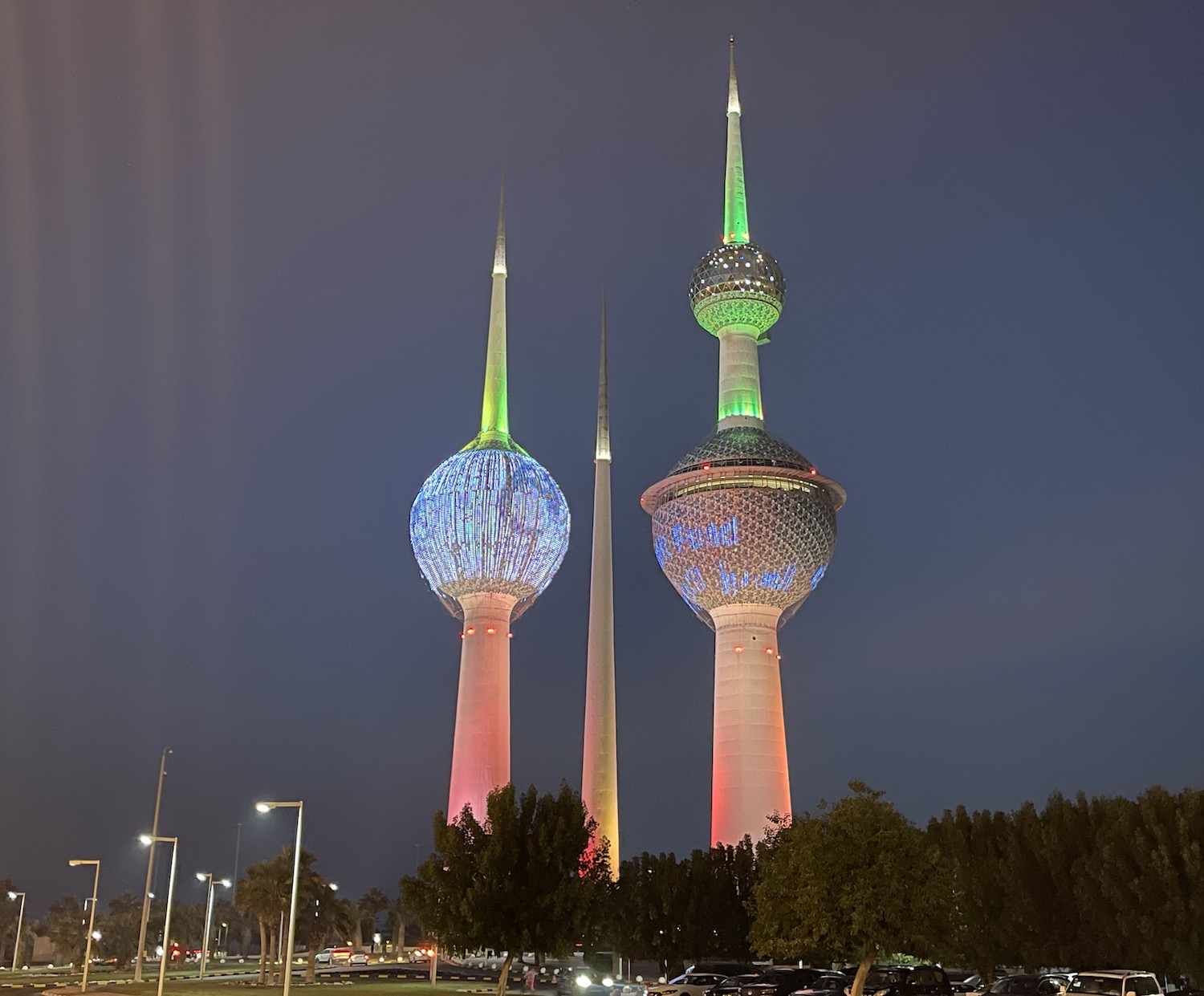
On a promontory off the north tip of the city are its most distinguishing landmarks, the backdrop to so many TV reports during the Gulf War, the Kuwait Towers. They are a trio of water towers, designed by Danish architect Malene Bjørn in the 1970s, that appear different from but are also part of the system of dozens of blue-and-white candy-striped water towers that can be seen in clusters all over town. They are covered in what look like massive sequins that are especially brilliant when lit at night. The main tower is 187 metres high with a restaurant in its lower ball and a café in its upper, ideal places from where to get your bearings.
Near them is Dasman Palace, scene of a particularly gory battle in the Gulf War. This is a residence of the ruling Emir (currently Sheikh Nawaf Al Ahmad Al Jaber Al Sabah, the sixteenth consecutive Al Sabah leader). Like all the royal palaces, sadly this is not open to visitors.
Beyond that is the rather scruffy downtown business district. There are the beginnings of a skyline, including the Al Hamra Tower (completed in 2011, and at 414m the thirty-sixth tallest building in the world) and Liberation Tower (1993, 372m, thirty-ninth), and there are a lot of cranes busily at work too. However, this is nowhere near par with the current construction sites in Manama and Riyadh, let alone the already developed cities of Doha and Dubai.
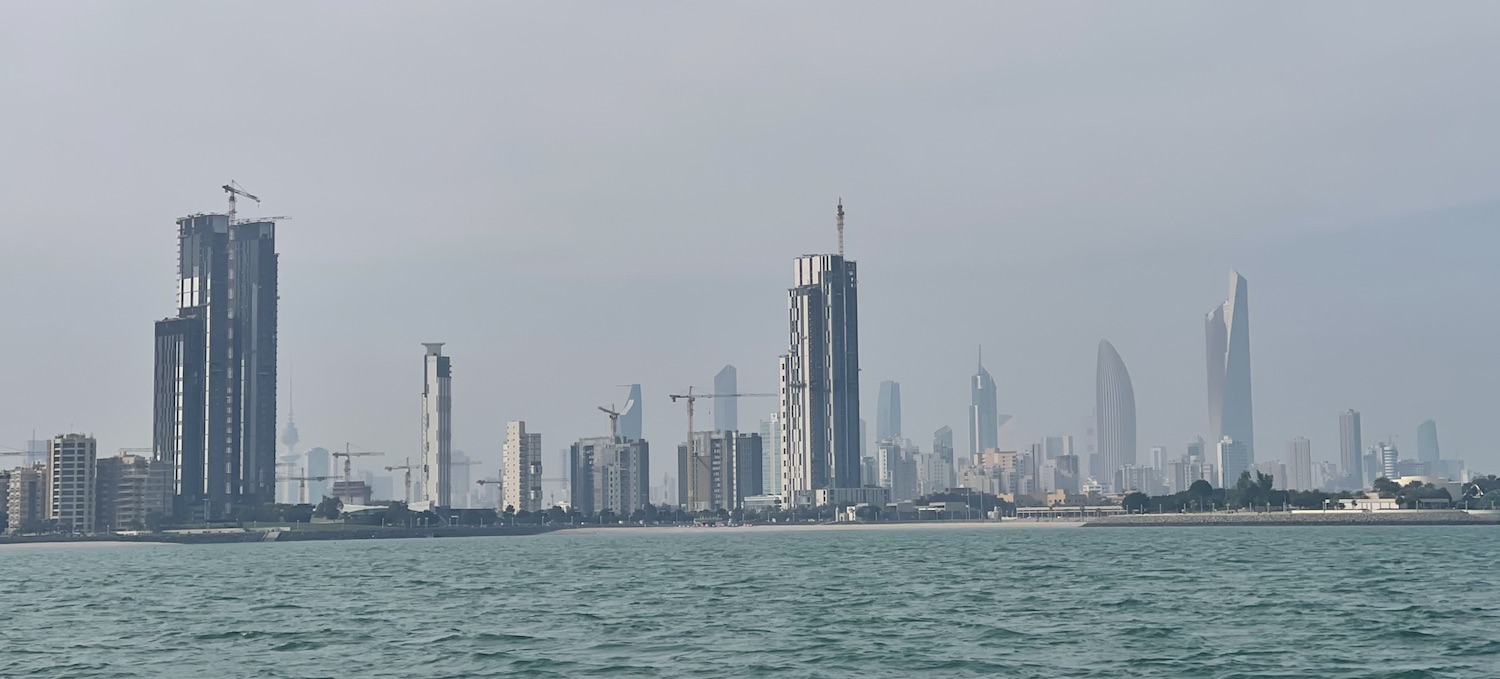
Among these new builds is where the old town was protected by a 5km-long 30m-high brown mudbrick wall that was erected in a semi-circle in just two months in 1920. Although that was torn down in 1957, hidden away seemingly randomly in the downtown area today are the five gates that once stood in it: Bneid Al Qar, Al Shamiya, Al Maqsab, Al Jahra and Al Shaab. They are not terribly glamourous, though this last one is located prettily in the heart of Al Shaheed Park. This is the downtown green lung, sculpted in a contemporary style with marble walkways, huge pieces of modern art, and sharp-edged water-pools; there is also a jogging track and a cycling path. Also around here are the whacky Mirror House, where tours of the Khalifa and Lidia Qattan Art Museum are booked in advance online, and Bayan Palace, another royal residence.

Running south-west from the Kuwait Towers is a 10km corniche, Arabian Gulf Street, full of little parks and beaches. Not far down is the wooden dhow fishing boat harbour, a constant scene of comings and goings. Next door to that is the fish market, a large hall of retail kiosks that is busy most of the day but a total riot of commotion in the afternoon when the catch has just come in and fish are auctioned off wholesale.
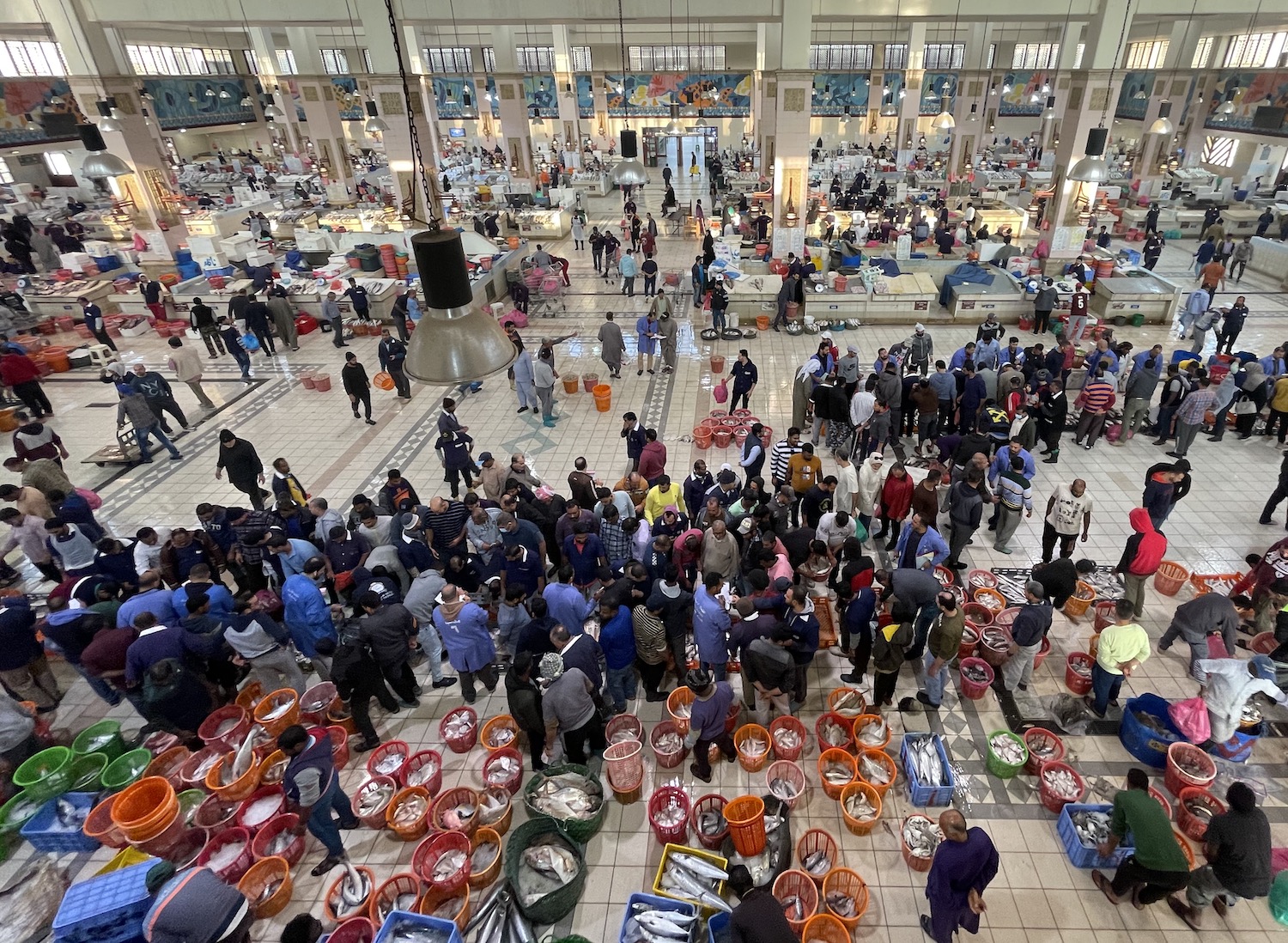
Further along are several impressive government buildings, including the Ministry of Foreign Affairs and the National Central Bank. The long series of royal palaces is called Al Diwan Al Amiri, the foundations for which were laid in 1904 though they have been extended several times since. This is a residence of the Crown Prince (currently Sheikh Mishal Al Ahmad Al Jaber Al Sabah), the designated successor to the Emir but who is not necessarily his eldest son. The National Museum, established in 1983, used to house widely respected exhibitions portraying Kuwaiti life and traditions through the ages. However, it was particularly badly damaged and then looted during Saddam’s occupation. It has since been renovated, of course, but unfortunately it lost a lot of its lustre along with its artefacts.
Kuwait is a constitutional monarchy and has the most checks on authoritarian rule in the whole region. Although the Emir and the Crown Prince have the final say in affairs, since independence the architecture of government has included an appointed prime minister (currently Sheikh Sabah Al Khaled Al Hamad Al Sabah) who runs the country day-to-day. The office-holder must – naturally – also be an Al Sabah.
Prime ministers are in turn answerable to an elected parliament that has been known to bite as well as bark. Several have been forced out of office, and not only during the Arab Spring. As lately as April 2022 a prime minister resigned when faced with losing a vote of confidence in the combative legislature, and in October 2022 another was ejected following gains by opposition candidates in parliamentary elections. Moreover, Jaber Al Mubarak Al Hamad Al Sabah, who served until 2019, recently became the first former prime minister to be arrested on corruption charges.
This parliament is based in the fabulous National Assembly building that was completed in 1982 at the end of the Golden Era of modernisation. It was designed by the Danish architect Jørn Utzon, who is best known for the Sydney Opera House. It is opposite Al Erada Square and a scrubby little beach, where the demonstrators gathered in vast numbers in 2011-12. At weekends, this area is crowded with Filipino maids picnicking, South Asian men playing cricket, and families taking in the great view out to sea.
South of here is the National Cultural District, the centrepiece of which is the large set of expressionist buildings in geometric designs that comprise the Sheikh Jaber Al Ahmad Cultural Centre. In addition to the National Theatre and the largest Opera House in the Middle East, there is a row of fashionable restaurants including Cocoa Room, which is always full in the mornings, and White Robata, specialists in grills, notably sous vide wagyu ribs, which has long been thought the city’s best eatery and needs to be booked weeks in advance.
Arabian Gulf Street eventually leads to the small port, the Free Trade Zone, and the start of the fourth longest sea bridge in the world, behind one in the US and two in China, that runs for 36km across Kuwait Bay.
Opposite the Al Diwan Al Amiri is the Grand Mosque, the largest of the 800 in the city, able to accommodate 10,000 men in the main prayer hall and 950 women in a separate chamber. Completed in 1986, it is open to non-Muslims who can take free private guided tours from Gate 5 between 9-11am and 4-6pm. These last 60-90 minutes and ours was with a woman educated in Manchester who was able to offer genuine insights about Kuwaiti religion, culture and history.
Like much of the region, Kuwait became significantly more conservative – for the first-time banning alcohol, enforcing Ramadan fasting, and compelling women to cover their heads – in the wake of the Iranian Revolution in 1979. About 70% of Kuwaitis are Sunni and 30% Shia, and despite comparative moderation and stability, in recent years Kuwait has been accused by both the US and Russia of funding both Al Qaeda and ISIS.
Inland a little from here is the wonderful collection of souqs, dating back 200 years, that jumble together under rooved boulevards to form the heart of the city. One of these was Souk Al Manakh, the country’s unofficial stock market that collapsed and triggered the 1980’s recession. Though damaged during the Gulf War, this maze has been renovated to recover its ancient flavour.
The biggest is Souq Mubarakiya, though many others are connected to it, specialising in gold, jewellery and antiques, bespoke tailoring and traditional clothing, dates and spices, musk and oud. In and around the courtyard at one end, near Masjid Al Bahar (Sea Mosque), there are dozens of outdoor traditional street food vendors with tables and chairs spilling all over; most specialise in Iranian cuisine and those in the Al Shamam brand are particularly well thought of for both food and ambience.
Near the souq are some major hotels, including the St Regis and Four Points By Sheraton, home of the English Tea Lounge, which has all the traditional trappings you would expect.
In contrast to the old souq is The Avenues, one of the biggest shopping malls in the world, in my view the pleasantest on the Arabian Peninsula, and the highest-rated attraction in Kuwait on Trip Advisor. Its external space-age design is a skin over a series of long and wide boulevards built in the style of elegant two-story buildings, providing almost a thousand retail outlets, eating and drinking spots, and entertainment venues. There are more five star hotels here, including the Hilton and the Waldorf Astoria, home of the chichi Roka for contemporary Japanese. A little south-west of here is the gorgeous conical-domed architectural masterpiece, Sheikh Fatima Mosque.
Back at the Kuwait Towers, the corniche also goes south-east for 15km, arcing out to the most easterly point a little beyond Marina Mall. There is a lovely promenade, ideal for running, all the way along. Marina Beach, the prettiest stretch of sand in the city, is a long and deep curve with palm trees and great vistas back to the downtown skyline faintly visible in the distance. In the actual marina here, at the Ikarus booth you can book tickets for the ferry to Failaka Island, as well as quarter- and half-hour little boat tours that go as far as the Kuwait Towers for decent photos.
Close to here, in a building sitting on its own but in a design that is seeking attention, with an elegant modern Arabic interior design that shows close attention to detail, is Dar Hamad, the finest authentic Kuwaiti dining there is, and probably my favourite local cuisine in the whole Arabian peninsula. It is open for dinner and lunch, when the signature dishes include lamb shank, but it is primarily renowned for breakfast (8am to 12 noon) when large trays bend to the weight of shakshouka eggs in spices, feta and halloumi, houmous, labneh and zaatar, fried falafel, grilled cauliflower and halwa among dozens of little dishes. No wonder that about 40% of the population of Kuwait is overweight, making it one of the most obese countries in the world.
Near the eastern tip of the city is the unusual pyramid-shaped Sheikh Nasser Al Sabah Mosque and down the coast from here, beyond the two renowned Tareq Rajab Museums of Islamic Art and Islamic Calligraphy in the Salmiya tourist district, are some fine beach resorts: the Movenpick, the Regency, the Palms and the Radisson Blu, home to Al Boom steak and seafood restaurant; that is in a large wooden dhow, which is a bit gimmicky, but the fare is excellent. Though all are great places to see the sun rise and then loaf by the pool, the best of them is the Jumeirah Beach Hotel, by Messilah Beach, which has been undergoing some construction.
Although you do occasionally see display cabinets in hotels with relics and artefacts from when those buildings were bombed by Saddam’s forces, Kuwait is surprisingly short of monuments and memorials relating to the Gulf War. There was a Kuwait House for National Works Museum, with sections on the country’s history and the invasion, but it was mysteriously closed by the government in 2018.
One of the best is south of here at Al Qurain Martyrs’ House, the remains of a building where nineteen resistance fighters with machine guns held out here for ten hours on 24 February 1991 against the surrounding Iraqi forces; ultimately twelve were killed and seven fled. It is free and open from 8.30 til 12.30 in the mornings and then 4.30 til 8.30 in the afternoons; it is at its most haunting at twilight.
Rest Of Kuwait
Beyond the big city, obviously Kuwait is rather small, so it is easy to see all that it has – which is not a lot – in a few days. There is a day trip by boat out to Gulf War relics and weirdness on Failaka Island; there is a 90km drive north through the desert to the Iraq border and back via a loop around Kuwait Bay; and there is a 110km drive south towards the Saudi border to learn about the local oil and gas industry and to have fun at camel racing. Most business hotels seem to rent cars only with a driver, but at the airport there are bunches of car hire kiosks on both the ground floor and the basement of arrivals. Getting around is not expensive since at the time of writing petrol at the pump costs about €0.25 per litre compared to the global average of €1.50.
Failaka Island, 12km long and 6km wide, lies 20km due east of Kuwait City in the yawning mouth of Kuwait Bay, 50km south-east of where the Tigris and Euphrates empty into the Persian Gulf. Ikaros ferries leave from near Marina Beach and take about 45 minutes to reach the main town of Al Zawr. As far as I can tell they are supposed to go on Mondays, Tuesdays, Fridays and Saturdays, departing at 1pm and returning at 7pm. However, the information even from the Ikaros kiosk is contradictory and unreliable, and we actually caught one at 1.30pm on a Thursday.
Failaka has been inhabited since the Bronze Age and became an important staging post on the trade routes to India and China. This history has left several sites of archaeological interest, especially the remains of a Christian monastery and the ruins of a Hellenistic fortress. Both are under excavation and awaiting UNESCO World Heritage status, though neither are presently of appeal to tourists.
Recently, there has been an optimistic attempt to create a seaside tourist vibe at a Heritage Village with a hotel, a couple of restaurants, a bouncy castle and a shack on the beach hiring jet-skis. However, the whole place feels tired and sad, and with a maximum of forty visitors on the days when the boat does run most of these facilities remain largely unused. About the best of it is a farm of about 150 camels owned by the Emir.
These aspiring tourist attractions have been spatchcocked onto an island that is in fact primarily of military interest. Much of it is currently a US army base, and Al Zawr itself is little more than a ghost town that was damaged and deserted during the Gulf War. The entire population of 2,000 fled – and most have never returned – when Failaka was captured by 1,400 Iraqi soldiers who laid landmines on its beaches and used its buildings for target practice. Of course, it is this that makes the trip worthwhile.
There is a one hour tour, with a charmless guide on a yellow bus that leaves the hotel when it has at least ten passengers, that bimbles around the abandoned homes, souq, school, bank and mosque. Some are riddled with bullet holes or gape with Scud missile damage; more are simply decaying from emptiness. There is also a graveyard of twenty or so Iraqi tanks and other military vehicles, rotting away and sinking into the sand since being left behind as the troops bolted in 1991. This is the most evocative evidence of the war scars that define the recent history of this country that we found anywhere.
Back on the mainland, it is a 30km drive west from downtown Kuwait City to what used to be the town of Al Jahra but is now basically another suburb of the sprawling metropolitan area. A Red Fort was built here in 1915, and just five years later it became the scene of a major battle that helped turn back invaders from Saudi Arabia. It is an important landmark, and to get in you need to show your passport, but it is neither impressive nor photogenic as all there is to see are a couple of canons at the entry gate and a water well in the middle of the courtyard formed by brown/red mudbrick walls.
Out of Al Jahra, Sheikh Jaber Al Ahmad Al Sabah Road runs due north through the desert for an hour to Abdali, an oasis town of crop farms on the border with Iraq, before it continues on to the city of Basra. It was this six-lane road, identified on Google Maps as Highway 80 but colloquially known as the Highway of Death, that 100,000 soldiers in Saddam’s armoured divisions used for their invasion at the start of August 1990.
This is also the route that the remaining 80,000 of those troops took when returning back again at the end of February 1991. At that time this road became particularly infamous for a turkey shoot massacre that is believed to have caused President George Bush to stop the war. Allied forces trapped a convoy of up to 2,000 Iraqi vehicles and then for over ten brutal hours dropped cluster bombs on them, killing at least 500 people.
These days, an electric fence protects the border, which is open to travellers though foreign nationals are strongly advised not to cross it for security reasons. The Kuwaiti desert is littered with rubbish, notably plastics, as well as large tent cities and small pre-fab villages, where locals come to spend leisure time. There are scores of oil wells – as Saddam’s troops retreated, in a scorched earth tactic they set fire to as many as 700 – plus occasional military bases and random mosques, though oddly we saw not one war memorial.
From Al Jahra, Highway 801 curves for 75km along the north coast of Kuwait Bay to Boubyan Bridge; this leads to uninhabited Boubyan Island, which is Kuwaiti territory claimed by both Iraq and Iran as well but in any case inaccessible to visitors. All along Highway 801, where the landmines have been cleared and the sand blows over the tarmac, camels are steered by tribal herders. Also here is the highest point in the country; in fact, it is one of the few places not totally flat. Mutla Ridge is a 300m-tall rocky escarpment and there is a short hike up to its hill top. The diggers, camp sites and trailer parks nearby are evidence that the authorities are hoping to turn this into a tourist attraction too.
However, as the naked eye can tell, right now, around here, there is absolutely nothing, except the other end of the bridge that leads back across Kuwait Bay for half-an-hour to Kuwait City. Yet this Sheikh Jaber Al Ahmad Al Sabah Causeway, which opened in 2019, costing US$3.6 billion and taking four years to construct, is a key plank of Vision 2035. It was funded partly under the Belt-And-Road initiative by China, which since 2016 has been Kuwait’s single biggest trading partner.
The idea is for this bridge to connect Kuwait City with Silk City, a development intended to house almost half a million people. However, that is still on the drawing board with an earmarked budget of US$130bn and an estimated completion date of 2035. All you get at the moment from driving across the bridge is a terrific panorama of Kuwait City.
From downtown, it is about forty-five minutes south to Al Ahmadi, a town built in the 40s and 50s by the Kuwait Oil Company to house its workers in the booming new industry. Kuwait has the sixth largest oil reserves in the world, causing it to have the highest valued currency, the dinar, and the fifth richest Gross National Product per capita. Surprisingly, it is worth making the trip to Al Ahmadi for the Ahmad Al Jaber Oil & Gas Exhibition (open 8am to 6pm with 2-hour tours every half an hour, but closed on Fridays and Saturdays).
About half an hour south of here, past the Al Zour thermal power station, is where Kuwaitis come to play by the sea. Around Bnaider, 90km from Kuwait City and just 20km from the Saudi border, there are private chalets and villas all along the coast. A bit further down at Al Khiran a whole new city is being carved out of the desert, with construction workers cutting canals from the sea into rigid formation to create space for artificial beaches and luxury accommodation in just the kind of development they love in this region.
Heading back up through the desert rather than the coast, it takes about 90 minutes to reach the village of Al Abdaliyah. Near here is the Kuwait Camel Racing Club, hosts of the only track in the country, which is just 45 minutes south-west of Kuwait City. Eight races every Saturday take place from October to April between roughly 1pm and 3pm, though they are subject to last minute changes.
Camel racing is unpretentious and this is one of the most intimate stadiums in the Arabian Peninsula; it is very much not aimed at scarce foreign tourists and there are unlikely to be more than a dozen or so spectators. You can wander around the paddock where owners saddle up robot jockeys, which replaced children back in 2005, and then watch trainers try to catch their returning dromedaries as they bound along after each race. There is a tumbledown grandstand overlooking the finishing line that has TV screens, large club chairs and Arabic coffee supplies. And best of all it is possible to drive on the tarmac all the way around the track rails as part of the horn-blowing light-flashing gaggle of vehicles that pursue the animals and from which the owners control the robot whips. It is a great way to feel part of the action at a truly iconic Arab sport.
